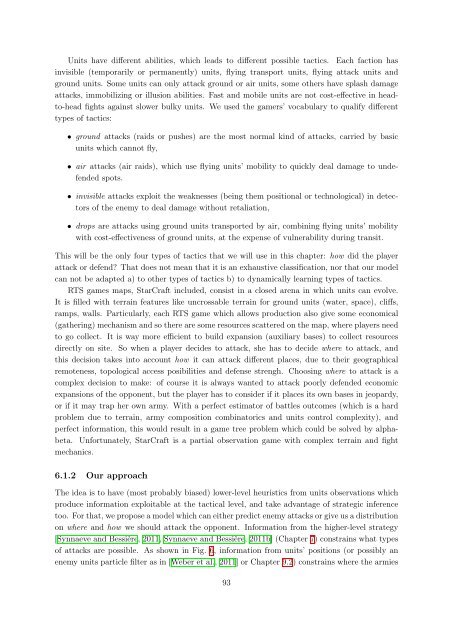Bayesian Programming and Learning for Multi-Player Video Games ...
Bayesian Programming and Learning for Multi-Player Video Games ...
Bayesian Programming and Learning for Multi-Player Video Games ...
Create successful ePaper yourself
Turn your PDF publications into a flip-book with our unique Google optimized e-Paper software.
Units have different abilities, which leads to different possible tactics. Each faction has<br />
invisible (temporarily or permanently) units, flying transport units, flying attack units <strong>and</strong><br />
ground units. Some units can only attack ground or air units, some others have splash damage<br />
attacks, immobilizing or illusion abilities. Fast <strong>and</strong> mobile units are not cost-effective in headto-head<br />
fights against slower bulky units. We used the gamers’ vocabulary to qualify different<br />
types of tactics:<br />
• ground attacks (raids or pushes) are the most normal kind of attacks, carried by basic<br />
units which cannot fly,<br />
• air attacks (air raids), which use flying units’ mobility to quickly deal damage to undefended<br />
spots.<br />
• invisible attacks exploit the weaknesses (being them positional or technological) in detectors<br />
of the enemy to deal damage without retaliation,<br />
• drops are attacks using ground units transported by air, combining flying units’ mobility<br />
with cost-effectiveness of ground units, at the expense of vulnerability during transit.<br />
This will be the only four types of tactics that we will use in this chapter: how did the player<br />
attack or defend? That does not mean that it is an exhaustive classification, nor that our model<br />
can not be adapted a) to other types of tactics b) to dynamically learning types of tactics.<br />
RTS games maps, StarCraft included, consist in a closed arena in which units can evolve.<br />
It is filled with terrain features like uncrossable terrain <strong>for</strong> ground units (water, space), cliffs,<br />
ramps, walls. Particularly, each RTS game which allows production also give some economical<br />
(gathering) mechanism <strong>and</strong> so there are some resources scattered on the map, where players need<br />
to go collect. It is way more efficient to build expansion (auxiliary bases) to collect resources<br />
directly on site. So when a player decides to attack, she has to decide where to attack, <strong>and</strong><br />
this decision takes into account how it can attack different places, due to their geographical<br />
remoteness, topological access posibilities <strong>and</strong> defense strengh. Choosing where to attack is a<br />
complex decision to make: of course it is always wanted to attack poorly defended economic<br />
expansions of the opponent, but the player has to consider if it places its own bases in jeopardy,<br />
or if it may trap her own army. With a perfect estimator of battles outcomes (which is a hard<br />
problem due to terrain, army composition combinatorics <strong>and</strong> units control complexity), <strong>and</strong><br />
perfect in<strong>for</strong>mation, this would result in a game tree problem which could be solved by alphabeta.<br />
Un<strong>for</strong>tunately, StarCraft is a partial observation game with complex terrain <strong>and</strong> fight<br />
mechanics.<br />
6.1.2 Our approach<br />
The idea is to have (most probably biased) lower-level heuristics from units observations which<br />
produce in<strong>for</strong>mation exploitable at the tactical level, <strong>and</strong> take advantage of strategic inference<br />
too. For that, we propose a model which can either predict enemy attacks or give us a distribution<br />
on where <strong>and</strong> how we should attack the opponent. In<strong>for</strong>mation from the higher-level strategy<br />
[Synnaeve <strong>and</strong> Bessière, 2011, Synnaeve <strong>and</strong> Bessière, 2011b] (Chapter 7) constrains what types<br />
of attacks are possible. As shown in Fig. 6, in<strong>for</strong>mation from units’ positions (or possibly an<br />
enemy units particle filter as in [Weber et al., 2011] or Chapter 9.2) constrains where the armies<br />
93


